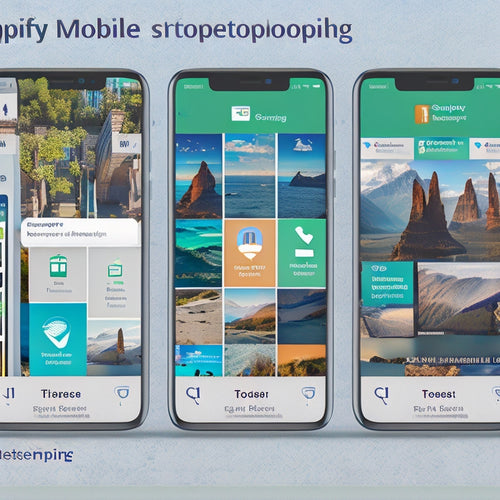
What Ecommerce Digital Product Marketing Strategies Work?
Share
You can boost your ecommerce sales and customer loyalty with proven digital product marketing strategies. Craft compelling product descriptions that drive 10% more sales. Leverage influencer marketing campaigns to increase conversions. Build effective email marketing funnels that lift sales by 20% and loyalty by 40%. Optimize product pages for SEO to increase organic traffic by 25% and conversions by 15%. Create engaging product videos that influence 70% of purchasing decisions. Run paid social media ads with targeted audience segmentation. And, utilize customer reviews to build trust and credibility. By applying these strategies, you'll be on your way to ecommerce success - and that's just the starting point for opening up your growth potential.
Key Takeaways
• Crafting compelling product descriptions with visual storytelling and emotional appeal can increase sales by up to 10%.
• Leveraging influencer marketing campaigns can drive conversions and sales, with micro, macro, and niche influencers offering different benefits.
• Building effective email marketing funnels with automated sequences and personalization tactics can increase sales by 20% and boost customer loyalty by 40%.
• Optimizing product pages for SEO benefits through image optimization, keyword research, and internal linking can increase organic traffic by 25% and boost conversions by 15%.
• Creating engaging product videos that demonstrate solutions effectively in under 2 minutes can influence purchasing decisions for over 70% of consumers.
Crafting Compelling Product Descriptions
When it comes to converting browsers into buyers, your product description is often the make-or-break factor, as it can increase sales by up to 10% if done correctly. You're not just listing features and specs - you're crafting an experience that resonates with your target audience.
To do this, you need to tap into the power of visual storytelling. Use vivid descriptions that paint a picture in the customer's mind, making them imagine how your product will improve their life.
But that's not all - you also need to appeal to their emotions. What problems does your product solve? How will it make them feel? By combining visual storytelling with emotional appeal, you'll create a product description that drives sales.
For example, instead of saying 'our product is waterproof,' say 'our product will keep you dry and confident on your next adventure, no matter the weather.' By doing so, you'll create a connection with your customer that goes beyond just a transaction.
Leveraging Influencer Marketing Campaigns
By incorporating influencer marketing campaigns into your ecommerce strategy, you can tap into the trust and loyalty that social media personalities have built with their followers, driving an average increase of 10% in conversions and 15% in sales.
To maximize the impact of your influencer partnerships, focus on engagement metrics such as likes, comments, and shares to gauge the success of your campaigns. When choosing influencers to partner with, consider the trade-off between micro and macro influencers. Micro influencers offer higher authenticity and engagement rates, while macro influencers provide broader reach and visibility.
| Influencer Type | Benefits |
|---|---|
| Micro Influencers | Higher engagement rates (2-5%), authenticity, and niche audience targeting |
| Macro Influencers | Broader reach (millions of followers), increased brand awareness, and prestige |
| Niche Influencers | Targeted audience alignment, high engagement rates, and cost-effectiveness |
| Celebrity Influencers | Massive reach, prestige, and brand awareness, but often high costs and low engagement |
Building Email Marketing Funnels
Building email marketing funnels allows you to nurture leads and convert them into customers, resulting in an average increase of 20% in sales and a 40% boost in customer loyalty. By creating targeted email campaigns, you can move potential buyers through the sales process, building trust and anticipation along the way.
Here are some key strategies to get you started:
-
Automated sequences: Set up triggered emails that respond to specific actions, such as abandoning a cart or making a purchase.
-
Personalization tactics: Address customers by name, and tailor your content based on their interests, behaviors, and demographics.
-
Segmentation: Divide your list into distinct groups based on their needs and preferences, ensuring that each group receives relevant messages.
- A/B testing: Continuously experiment with different subject lines, CTAs, and content to optimize your email performance.
Optimizing Product Pages for SEO
Your product pages are where the rubber meets the road in ecommerce, and optimizing them for SEO can increase organic traffic by 25% and boost conversions by 15%. To maximize your product pages' potential, focus on the following strategies:
| SEO Element | Optimization Technique | Impact on Conversions |
|---|---|---|
| Image Optimization | Use descriptive alt tags, compress images, and leverage schema markup | 5% increase in conversions |
| Keyword Research | Identify relevant long-tail keywords, incorporate them in product descriptions, and meta tags | 8% increase in organic traffic |
| Internal Linking | Link to related products, categories, and content to improve user experience and reduce bounce rates | 3% increase in average order value |
| Meta Tags | Craft compelling title tags, descriptions, and header tags to improve search engine rankings | 10% increase in click-through rates |
Creating Engaging Product Videos
More than 70% of consumers say that product videos have helped them make a purchasing decision, making them an essential element in your ecommerce marketing strategy.
You're likely no stranger to the importance of product videos, but are you maximizing their potential? To create engaging product videos, you'll need to focus on storytelling techniques that resonate with your target audience.
Here are some actionable tips to get you started:
-
Keep it concise: Attention spans are short, so keep your videos under 2 minutes.
-
Show, don't tell: Instead of listing features, demonstrate how your product solves a problem.
-
Use high-quality visuals: Invest in good camera equipment and editing software to guarantee your video looks professional.
- Add a clear call-to-action: End your video with a clear next step, such as visiting your website or making a purchase.
Running Paid Social Media Ads
When running paid social media ads, you'll want to focus on targeting the right audience to maximize your return on ad spend.
By following ad creative best practices and allocating your budget strategically, you can drive conversions and grow your customer base.
To get the most out of your paid social campaigns, you'll need to master these three key elements.
Targeting the Right Audience
By running targeted paid social media ads, you can pinpoint and reach high-intent buyers who are most likely to convert, increasing your digital product's visibility and driving sales. To guarantee you're targeting the right audience, you need to conduct thorough audience segmentation and demographic analysis. This involves identifying your ideal customer based on factors such as age, gender, location, interests, and behaviors.
Here are some key steps to help you target the right audience:
-
Define your target market: Identify your ideal customer based on their demographics, pain points, and buying habits.
-
Create buyer personas: Develop detailed profiles of your ideal customers, including their goals, challenges, and motivations.
-
Use social media analytics: Leverage social media analytics tools to gain insights into your audience's behavior, interests, and demographics.
- Refine your targeting: Continuously refine your targeting based on the performance data of your ads, making sure that you're reaching the most high-intent buyers.
Ad Creative Best Practices
Crafting high-performing ad creative that resonates with your target audience is crucial, as it can make or break the success of your paid social media ad campaigns. Research shows that ads with compelling visuals and clear messaging can increase conversions by up to 25%.
You need to create ads that grab attention, evoke emotions, and drive action. To do this, you must consider the psychological impact of color on your audience. Use colors that align with your brand's personality and evoke the desired emotional response. For instance, blue often conveys trust and reliability, while orange can stimulate excitement and urgency.
Furthermore, your font selection is crucial. Choose fonts that are easy to read, consistent with your brand's tone, and optimized for mobile devices. Sans-serif fonts like Open Sans and Lato are popular choices for digital ads.
Additionally, make sure your ad copy is concise, clear, and focused on the benefits of your product. Use social proof, such as customer testimonials, to build credibility and trust.
Budget Allocation Strategies
You've invested time and effort into creating high-performing ad creative, but now it's time to maximize your ROI by distributing your budget effectively across paid social media channels. To get the most bang for your buck, you need a solid budget distribution strategy.
Here are some actionable tips to optimize your budget distribution:
-
Conduct a marketing ROI analysis: Identify which channels are driving the highest returns and distribute your budget accordingly.
-
Use competitive pricing strategies: Analyze your competitors' ad spend and adjust your budget to stay competitive.
-
Distribute budget for product launch promotions: Boost your ad spend during product launches to maximize visibility and drive sales.
- Prioritize customer retention tactics: Distribute a portion of your budget to retargeting campaigns to secure customer loyalty and repeat business.
Utilizing Customer Reviews Effectively
Leveraging customer reviews as social proof is essential in ecommerce, as 85% of consumers trust online reviews as much as personal recommendations, making them a powerful influencer in driving conversions and sales.
You can't afford to neglect this critical aspect of your marketing strategy. To utilize customer reviews effectively, you need to curate them strategically. Review curation involves showcasing your best reviews in prominent places, such as your product page or homepage. This will help build trust and credibility with potential customers.
Another key tactic is testimonial integration. You can integrate customer testimonials into your marketing campaigns, such as email marketing or social media ads, to increase their reach and impact. By doing so, you'll be able to tap into the persuasive power of social proof and drive more sales.
Frequently Asked Questions
How Do I Handle Returns and Refunds for Digital Products?
You'll boost customer satisfaction by having a clear, flexible refund policy and communicating it upfront, setting expectations and providing hassle-free returns, ensuring a positive experience and encouraging repeat business and positive reviews.
Can I Use Affiliate Marketing for Digital Product Sales?
You can leverage affiliate marketing for digital product sales by partnering with influencers who reach your target audience, and amplifying promotions through targeted email campaigns, resulting in increased conversions and revenue growth.
Do Digital Products Require Special Licensing or Permits?
'You're not drowning in a sea of red tape, but you do need to navigate licensing requirements and permits for digital products. Guarantee you're legally compliant by researching regulations and obtaining necessary permits to avoid costly setbacks.'
How Do I Protect My Digital Product From Piracy?
To safeguard your digital product, you're taking the right step by prioritizing anti-piracy measures. Register for copyright protection to legally defend your work, and consider using digital rights management (DRM) tools to encrypt and track your product's distribution.
Can I Offer Free Trials or Demos for Digital Products?
You'll be surprised to know that 60% of consumers are more likely to buy a product they've tried before. Offering free trials or demos can boost conversion rates and increase customer engagement, as it lets them experience your digital product firsthand.
Related Posts
-
Best Sitemap Generator App for Shopify to Improve Your SEO
This article explores the benefits and tips for optimizing SEO using a sitemap generator app specifically designed f...
-
Best Sitemap Builder Shopify Apps for Your Business
This article examines the best sitemap builder Shopify apps available for businesses. It presents an objective analy...
-

Benefits of Listing Your App in the Shopify App Store
This article explores the benefits of listing an app in the Shopify App Store. It focuses on the advantages in terms...
